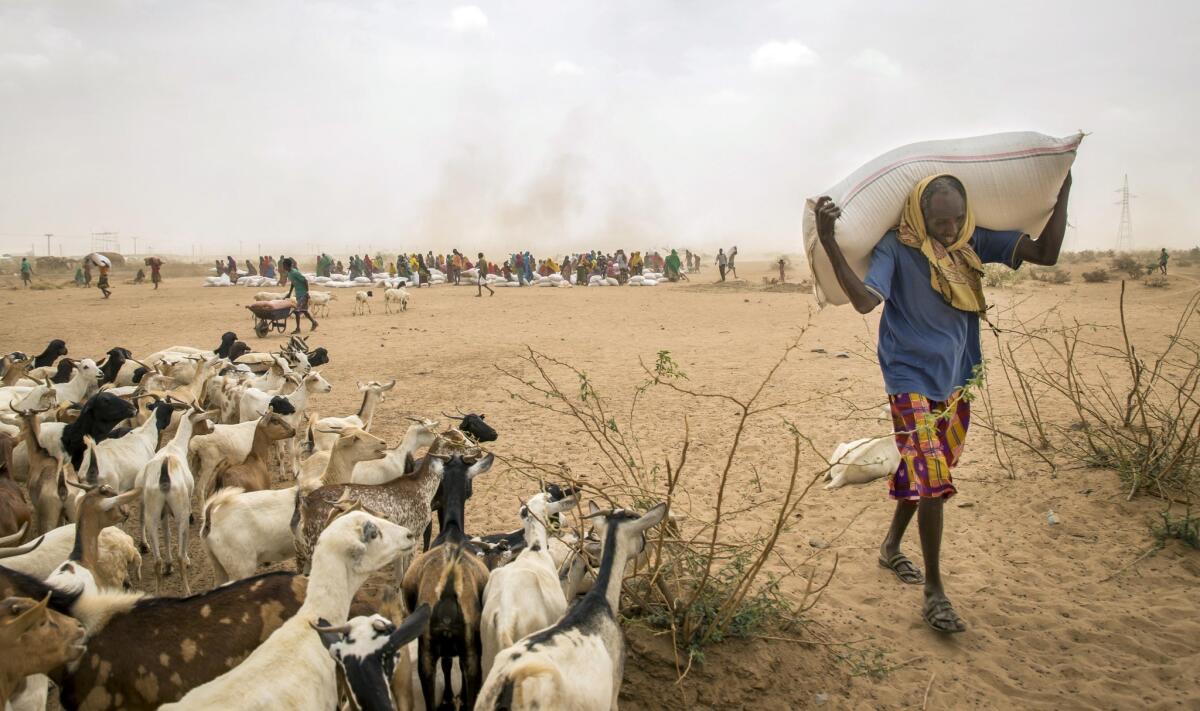Enduring Somalia drought puts hundreds of thousands at risk, U.N. warns

A man carries donated animal feed in Ethiopia, near the border with Somalia. The severe drought in Ethiopia has made headline news. But it has also scorched Somaliland and Puntland, semiautonomous regions in Somalia’s northeast.
- Share via
Reporting from northern Somalia — The severe drought in Ethiopia has made headline news. But it has also scorched northern Somalia, a region far less able to cope with the impact.
About 385,000 people are already facing a hunger crisis in semiautonomous Somaliland and Puntland, to the east.
The United Nations’ Office for the Coordination of Humanitarian Affairs, or OCHA, says an estimated 1.7 million people, nearly 40% of the 4.6 million people living in these areas, are in need of humanitarian assistance and livelihood support.
“Of these, 1.3 million people are at risk of slipping into acute food insecurity if they do not receive assistance,” it warned.
Ali Sheikh Omar Qabil, director of Somaliland’s Family Health Department at the Ministry of Health, said that the El Niño-linked drought had affected more than 650,000 people in Somaliland, and was particularly bad in its western regions. “People are suffering hunger, diseases and high rates of malnutrition,” he said.
Although the total number in need in neighboring Ethiopia is far greater – potentially 16 million could be drought-affected by the middle of this year out of a population of nearly 100 million – Somalia is far poorer, its government is less effective, and humanitarian access is much more limited.
As a result of El Niño, two consecutive rainy seasons have failed in Somaliland and Puntland.
Somaliland’s worst-affected regions are the scrublands of Awdal and Selel, whose shallow watercourses normally rejuvenate the arid land when it rains, providing pasture for livestock.
The forecasts for the Gu rains (April to June) “are less than favorable,” according to an OCHA statement. It has appealed for $105 million to urgently scale up “critical, life-saving” aid and to build resilience in northern Somalia. “If funding is not secured now, the consequences will be grave,” it added.
There have already been malnutrition-related deaths in Somaliland. “We know of about 12 persons who have died from malnutrition and hunger in the drought-affected areas of the region,” Adwal Gov. Mohamoud Ali Ramah said.
Pastoralists have been forced farther afield in a search for grazing. The Somaliland military and private transporters have been able to truck some of those who become stranded back to their areas of origin, including between 700 and 1,000 families from Ethiopia’s Somali region who crossed the eastern border looking for pasture.
“People are walking from the Guban plateau… toward the southern Oogo [mountains] after they lost all of their animals,” said Muhumed Abdi, from Gerisa village in the Selel region. “They are leaving behind whatever dies – whether human being or animal.”
Aden Buhane, a member of Awdal region’s drought response committee, said: “We are worried about the agro-pastoralists in Somaliland, because they lost their animals in the drought and they finished their stored food.”
Hamda Osman’s has lost his entire herd.
“The last one of my 18 cattle passed away last night, and we are running out of foodstuffs because we used to feed it our stored sorghum,” she said in Bus village, in the Gabiley region.
The lack of water and pasture is also forcing people to rely on private trucked water supplies, increasing the farmers’ costs and indebtedness.
Hamse Qalinle worries about his family’s future. “In [March 2014], I had $200 in savings, 10 [110-pound] sacks of sorghum and 20 cattle. But this year I have only five cattle, which need to be fed like children. It will be difficult to survive if rains do not come very soon.”
People are turning their hands to whatever they can to make ends meet. “After we lost our animals in the drought and our stored food ran out, we started to burn the trees for charcoal, which we sell in the market to feed our families,” said Husein Abdillahi, a father of five in Bus.
Food insecurity isn’t the only problem. There has been a measles outbreak in eastern Somaliland, with 29 cases confirmed in Buhoodle in the Togdheer region, on the Puntland border. Drought-affected pastoralists from Somaliland and Puntland have been moving into villages in the area, increasing the health risks and putting more pressure on struggling communities.
“Other diseases have broken out, including diarrhea, cough, pneumonia, and this is complicating [the situation for] the vulnerable children affected by the drought,” said Mohamoud Omar Yabe, coordinator of the Public Health Department in the Awdal region.
Neighboring Persian Gulf states -- Saudi Arabia, Qatar and Kuwait -- have reportedly begun to deliver some aid to Somaliland, but the extent of that assistance is unclear.
OCHA points out that funding levels are particularly low for critical sectors such as food security and nutrition. Of the $885 million requested in the 2016 Humanitarian Response Plan, only $97 million, or 11%, has been received so far.
“We have reached a critical point in Puntland and Somaliland,” Peter de Clercq, the U.N. humanitarian coordinator for Somalia, said in the OCHA statement.
“Urgent action is required right now. If not, we risk a rapid and deep deterioration of the situation, as drought conditions may worsen in the coming months.”
Jibril writes for IRIN News Agency. Read this story on their website here.
More to Read
Sign up for Essential California
The most important California stories and recommendations in your inbox every morning.
You may occasionally receive promotional content from the Los Angeles Times.










